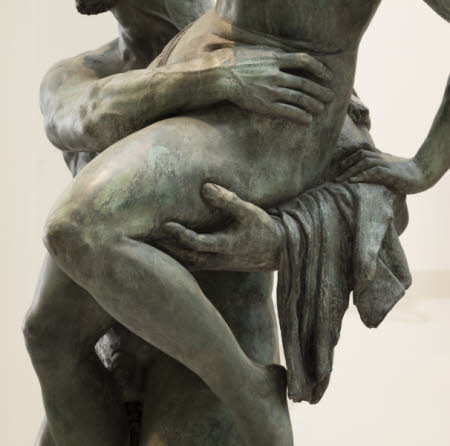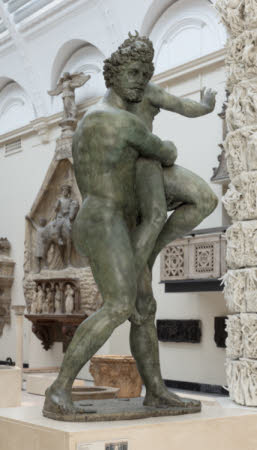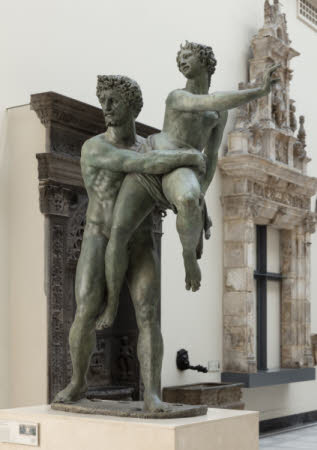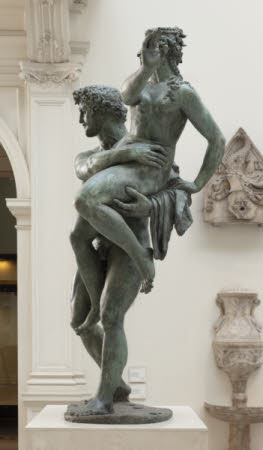Pluto and Proserpina
attributed to Vincenzo de' Rossi (Fiesole 1525 - Florence 1587)
Category
Art / Sculpture
Date
circa 1565 - 1570
Materials
Bronze on a stone plinth
Measurements
2255 x 1603 x 1203 mm; 1111 kg (Weight)
Place of origin
Italy
Order this imageCollection
Cliveden Estate, Buckinghamshire
NT 766000.2
Caption
According to classical mythology, having been struck by Cupid's arrow, Pluto (Hades in Greek myth), the king of the underworld, is said to have fallen in love with Proserpina (Persephone in Greek myth), daughter of Ceres (the Roman goddess of spring and plenty, identified with the Greek goddess Demeter) whilst she was gathering flowers in a meadow. According to the Roman poet Ovid in his Metamorphoses (Book 5, 385-424), Pluto then carried her away to the underworld. This dramatic sculptural group was cast in one piece, a difficult technical achievement at the time for such a large sculpture and, as can be seen from a drawing in the V&A by Gherardo Silvani of about 1593 [although also suggested as being probably by Ferdinando Ruggieri (1691-1741)] for the design of the Salviati garden, the group was intended to be part of a fountain. Proserpina is shown with a crescent moon diadem, associating her with the Roman goddess Diana (Selene in Greek) with whom she is sometimes identified. Pluto would have originally worn a crown. The contents of a 1570 document states that Pluto’s many-headed dog, Cerberus, was not part of the original composition - despite its presence in the small scale version (unattributed copy or study) in the Bargello, Florence.
Summary
Bronze sculpture on Portland stone pedestal, Pluto and Proserpina, attributed to Vincenzo de' Rossi (1525 - 1587), circa 1565/70. A muscular man with thick tightly curled hair strides along, his arms around a woman whom he holds up on his left. She flings her right arm across her, her hand held up flat, her left hand pressing against his left arm which comes round to hold her. The original cast group has been on long term loan to the V&A since approximately 1989. A 20th-century replica NT 766000.1 is at Cliveden. Formerly attributed to Giambologna (Douai 1529 - Florence 1608) without any documentary evidence. A recently discovered document dated 31 May 1570 makes it more certain that the sculptor was Rafaello Peri, not just the caster. Peri is twice recorded in 1565 as working with Vincenzo de' Rossi, one of the leading Florentine sculptors of the 16th century, but his activities are otherwise unknown. De' Rossi worked for several years in Rome before returning to Florence in 1560, where he was employed by the Medici Grand Dukes. His most notable works from this period are the over life-size marble groups of Hercules and Nessus and Hercules and Cacus (Palazzo Vecchio, Florence).
Provenance
Giovan Vettorio Soderini (1527-1597) who bought the work from the caster/sculptor Raffaello Peri; in 1594 it was sold to the Florentine Antonio Salviati (1554-1619); possibly by descent to Prince Camillo Borghese (1775-1832) as the Salviati residence had by 1819 been passed down through marriage; purchased by William Waldorf, the future 1st Viscount Astor (1848-1919) at the Villa Borghese sale in 1896 and brought to Cliveden; given to the National Trust in 1942
Makers and roles
attributed to Vincenzo de' Rossi (Fiesole 1525 - Florence 1587), sculptor Raffaello Peri (fl. Florence 1570), caster previously catalogued as attributed to Giambologna (Douai 1529 - Florence 1608), sculptor
References
Boström 1998 Antonia Boström, 'The Florentine Sculptor Raffaello Peri' The Burlington Magazine Shorter Notice, April 1998, CXL, no. 1141. pp. 263-4 Boström 1990 Antonia Boström, 'A Bronze Group of the Rape of Proserpina at Cliveden House in Buckinghamshire' The Burlington Magazine December 1990, CXXXII, no. 1053. pp. 829-840










